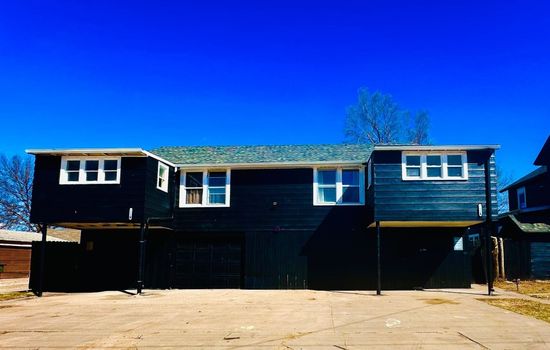Fort Larned National Historic Site is open from 8:30 AM to 4:30 PM, central time, every day.
There is no entrance fee to visit Fort Larned National Historic Site. All buildings and programs are free to the public.
From Larned, Kansas, take KS Hwy 156 west for 6 miles to uncover a meticulously preserved 19th-century military outpost, nestled along the historic Santa Fe Trail.
Fort Larned’s parking lot, about a quarter-mile from the park entrance, has sections for cars, buses, and RVs. Handicap parking is near the footbridge. No overnight parking or fees.
Accessibility & permits
Emergency
- Cell service availability:Full
Information not accurate?
Help us improve by making a suggestion.
Fort Larned National Historic Site, situated in the heart of Kansas, is a testament to the region’s rich and tumultuous history. This meticulously preserved army post from the 1860s and 1870s stands as a sentinel along the historic Santa Fe Trail, a pathway that once pulsated with the life of travelers, traders, and mail wagons.
The fort’s sandstone buildings, set against the rolling plains and the gentle flow of the Pawnee Fork, evoke a sense of rugged elegance. The complex, with its stables and corrals, is a window into the lives of the soldiers known as the Guardians of the Santa Fe Trail. As you walk the History and Nature trail, the landscape unfolds with its native grasses and wildflowers, home to a diverse array of birdlife.
During your visit, immerse yourself in the fort’s storied past through ranger-led tours and special events. The Tenth Cavalry, one of the African American regiments post-Civil War, once called this fort home, adding another layer to its compelling narrative. Seasonal events include historical garden weekends where you can pick vegetables and enjoy birding.
Nearby Larned, Kansas, bears the name of Colonel Benjamin F. Larned, the paymaster general whose legacy the fort honors. Though he never set foot in Kansas, his name is etched in the history of this land. For a deeper dive into local culture, visit the town’s quaint shops and restaurants, or explore the surrounding artisans’ studios.
In the evenings, the sky transforms into a canvas of hues, a perfect backdrop for the fort’s special events. Whether you are a history enthusiast, a nature lover, or simply a traveler seeking unique experiences, Fort Larned National Historic Site offers an authentic and evocative journey through time and place.
- Area (mi²)
- 1.1
- Annual visitors
- 40 000
- Established year
- 1859
Top 3 Facts about Fort Larned National Historic Site
The fort was moved 5 kilometers west in 1860 to its current location, where the army constructed buildings using local materials, replacing initial sod and adobe structures with stone and timber between 1866 and 1868.
In this pristine landscape, mule deer and white-tail deer roam among fox squirrels, prairie dogs, and coyotes. Armadillos occasionally appear at the northern edge of their range. The skies are filled with meadow larks, burrowing owls, and hawks, with eagles making rare appearances. Reptiles like bullsnakes, blue racers, and garter snakes inhabit the terrain, while beavers, muskrats, and badgers thrive in the waterways. This historic site is a living tapestry of wildlife and natural beauty, inviting visitors to immerse themselves in its rich ecosystem.
Along the meandering Pawnee River, the landscape is defined by natural defenses, with the river bordering two sides of the historic site. The area features shallow basins, or playas, filled with redeposited silt and fine sand, averaging a thickness of 6 feet, and grass-covered sand dunes composed of quartz, silt, and clay fragments from the Arkansas River valley. The serene waterways and unique geological formations create a tranquil and historically rich environment.
Family programs
- Junior Ranger
- Self-guided Tours
- Living History & Cultural Demos
- Workshops & Hands-on Activities
- Ranger-led Tours
Travel Tips
Plan Ahead
Visit in spring for living history events; plan a few hours to a day, depending on your interest. Park near the visitor center, anticipate moderate walks on mixed terrain, and bring snacks as dining options are limited. Check the calendar for special event weekends.
Pack Appropriately
Pack layers for variable weather, sturdy hiking shoes, and a daypack with essentials like water, snacks, and a first-aid kit. For camping, include a tent, sleeping bag, and multi-tool. Check seasonal needs and campground amenities before your trip.
Respect Wildlife
Respect the prairie ecosystem by staying on trails, avoiding prairie dog burrows, and not feeding wildlife. Bring water and sun protection during hot seasons. Leave no trace to preserve the natural habitat.
Stay Informed
Stay on marked trails, avoid ledges and fast-moving water, and check weather and fire alerts. For emergencies, call park authorities at 911 or the park’s emergency number. Be cautious of seasonal temperature changes and follow all park rules.
Seasons
Visit in spring for mild temperatures (60s-70s°F) and vibrant events. Attend the Remarkable Stories of the Indian Wars in April, experiencing the fort’s rich history amidst blooming landscapes. Ideal for outdoor enthusiasts and history buffs.
Experience the wild Kansas frontier this summer, with temperatures often in the 90s and occasional thunderstorms. Join the Memorial Day Weekend living history event or Independence Day celebrations, where volunteers and staff bring the 19th-century fort to life with period demonstrations and talks. Ideal for history enthusiasts and outdoor adventurers.
Visit in fall for crisp 60-70°F days and the Candlelight Tour in October, where lanterns illuminate historic buildings, recreating 1800s life amidst the Kansas prairie’s golden hues. Ideal for experiencing authentic frontier history.
Experience the serene winter landscape from December to February, with temperatures often below 42°F. Though snowy, the site’s historic charm is undiminished, offering a unique, tranquil visit amidst the well-preserved 19th-century structures.
Information not accurate?
Help us improve by making a suggestion.
Where to stay
Frequently Asked Questions
Ready to dive into what Fort Larned National Historic Site has to offer? Let’s tackle some of the burning questions you might have as you plan your visit!
-
The closest city to Fort Larned National Historic Site is Larned, Kansas, which is approximately six miles east of the site along KS Hwy 156.
-
You can bring your dog to the grounds and trails as long as they are on a leash, but they are not allowed inside any of the buildings. You must clean up after your dog and cannot leave them unattended. Service dogs are an exception and can enter the buildings.
-
You can park your RV, camper, or motorhome in the parking lot, which is about a quarter-mile from the site entrance and has sections for cars, buses, and RVs. However, you cannot camp or spend the night at the site itself. Nearby areas have RV campgrounds available.
-
During the Indian Wars, the fort played a crucial role in protecting the Santa Fe Trail from Native American resistance. In 1864, it was reinforced by the Fifteenth Kansas Cavalry and experienced a significant raid by Kiowas, leading to the arrival of Col. J.M. Chivington for reinforcements. The fort was also involved in Hancock’s War in 1867, supplying the Medicine Lodge Treaty and distributing gifts promised by the treaty the following year.






